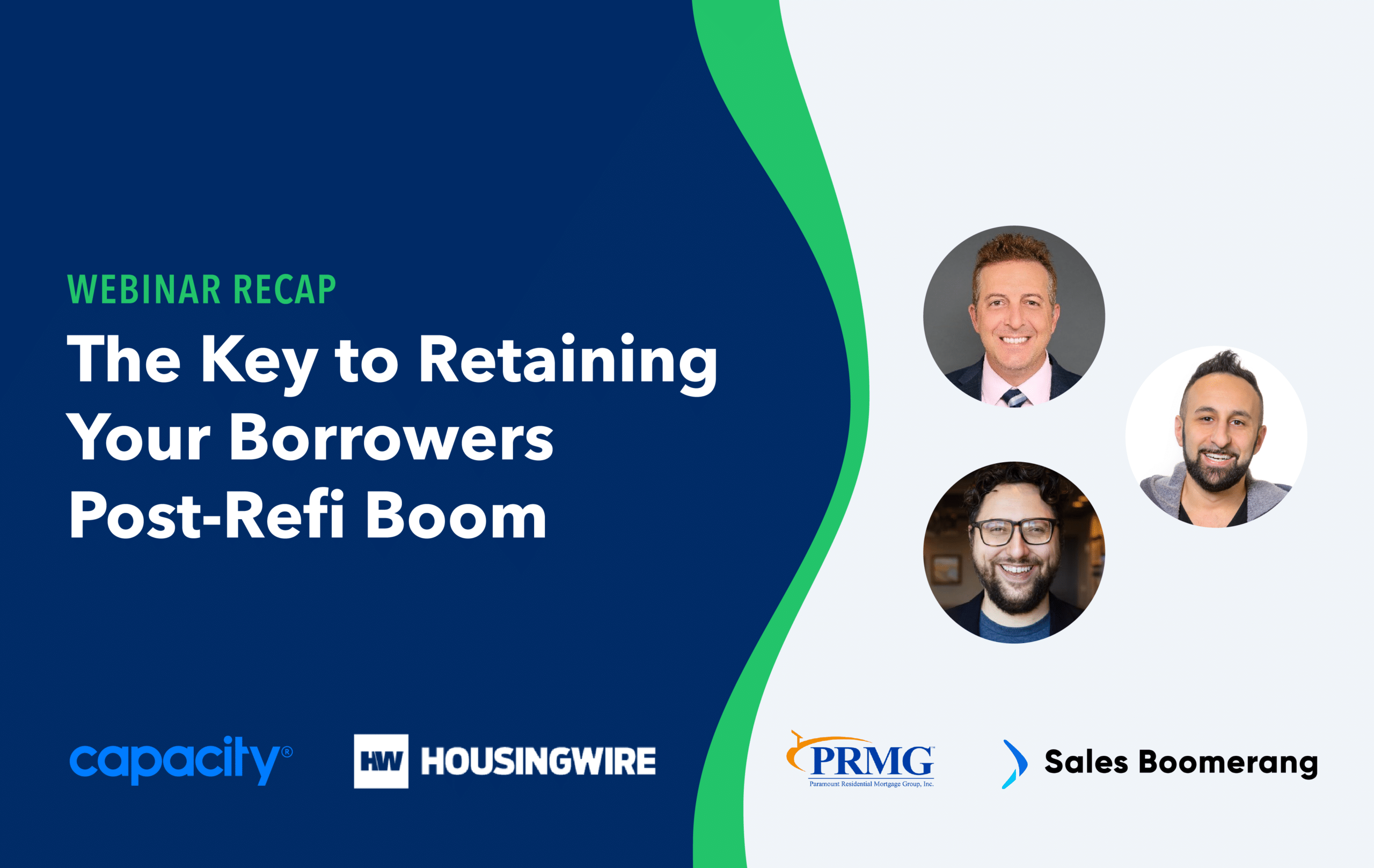At the beginning of 2020, mortgage rates were low and home sales were up, and then March happened. For only nine weeks, purchase applications were down, but then things picked back up. From the lender’s perspective, they’ve been busy ever since.
At the end of 2020, 4.3 trillion dollars of mortgages were originated and 2.8 trillion was from refinancing alone. Now that we’re in quarter two of 2021, there are sneaking suspicions that this refi-boom is coming to a close. Kevin Peranio, Chief Lending Officer at PRMG, David Karandish, CEO of Capacity, and Alex Kutsishin, CEO of Sales Boomerang, share how lenders can anticipate this and properly navigate the next steps.
How do you hold on to borrowers after the post-refi boom?
“It’s important to keep in touch with these borrowers regardless of the low rates they locked in,” explained Kevin. By staying in touch and checking in regularly, it’s more likely that you’ll be the originator they use in the future or recommend to their friends and family. This may seem like an additional burden, but technology can help you automate the small tasks associated with keeping in touch and continuing ongoing discussions with borrowers. Alex continued to encourage the originators to keep building on that connection. “If you’ve placed someone in the best possible loan that they can get, you want that to stay top of mind and build on that relationship,” added Alex.
David shared a stat from Stratmor Group that 87% of borrowers work with a lender either through an existing relationship or through a referral. “Keeping LOs happy and in place is crucial for lenders to keep their borrowers because that is the relationship that people are making their decisions based on,” said David.
How do you measure the impact on your business if you lose borrowers?
Kevin mentioned a few ways to measure impact. Lenders and originators can consider how many loans a borrower takes out in their lifetime (between 9 and 11). By considering how many loans they’ve taken out in the past, it’s easy to assume how many they will take out in the future. He also mentioned the Trigger feature in Sales Boomerang, which shows when a borrower gets their credit ran, so originators can quickly follow up with a borrower that has recently pulled their credit with someone else to find out if they’ve ultimately won or lost that deal. This feature gives actionable and measurable information that lenders can use to determine loss.
Kevin shared that if originators don’t want to work with a lender, that’s another measurable way to view the impact on business. He recommends staying on the ball and keeping borrowers with their originators. “If you don’t help your originators help themselves someone else will,” said Kevin. By arming staff with technology that can help them monitor borrowers and stay in touch, there’s a higher chance that they’ll continue working with you vs. a competitor. “The best thing about retaining originators is the repeat business and referrals,” shared Alex.
“Your borrower satisfaction and originator satisfaction are intertwined with one another,” said David. “You aren’t going to have happy borrowers if your loan officers are jumping left and right, and you won’t have happy loan officers if your borrowers aren’t having a great experience.”
It’s important that technology measures the satisfaction of your originators and borrowers to enhance their satisfaction. Capacity and Sales Boomerang can help lenders transform internal and external experiences at the same time.
What are the main reasons that a lender loses out on a borrower?
“A lender loses out on a borrower when relying solely on technology,” explained Kevin. “Technology is there to save you time, make you more efficient, help you scale, help you do more, and have more touches.” Nothing replaces a personal phone call and building a relationship, especially after the pandemic.
“The best technology helps you be more human,” added David. Completing paperwork and sending paperwork are not human-centric tasks, whereas getting on the phone and having a conversation is. Using technology to take on the manual processes and keeping your team focused on the human-centric tasks can help borrowers and originators continue working with you.
If you’re interested in hearing more about Retaining Your Borrowers Post-Refi Boom, watch the full webinar.


